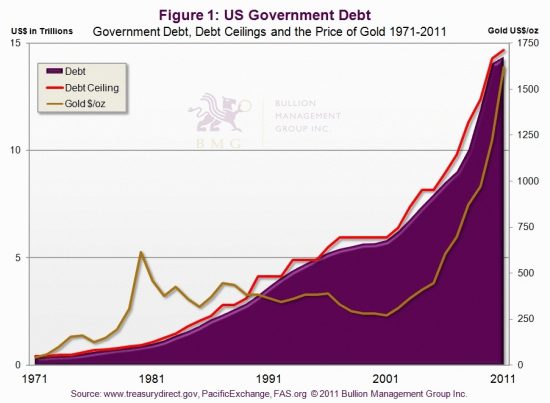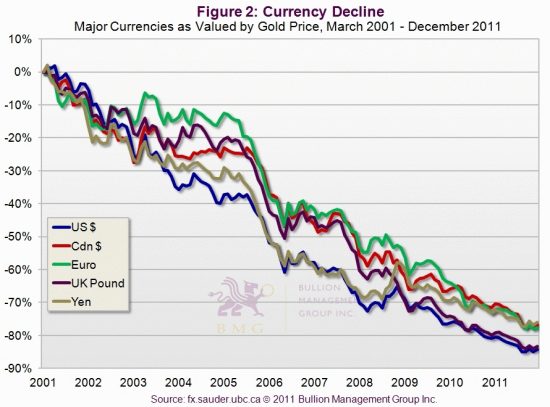This is not a typical bull market. Gold is not rising in value, but instead, currencies are losing purchasing power against gold and, therefore, gold can rise as high as currencies can fall. Since currencies are falling because of increasing debt, gold can rise as high as government debt can grow. Based on official estimates, America’s debt is projected to reach $23 trillion in 2015 and, if its correlation with the price of gold remains the same, the indicated gold price would be $2,600 per ounce. However, if history is any example, it’s a safe bet that government expenditure estimates will be greatly exceeded, and [this] rising debt will cause the price of gold to rise to $10,000…over the next five years. (Let me explain further.] Words: 1767. are losing purchasing power against gold and, therefore, gold can rise as high as currencies can fall. Since currencies are falling because of increasing debt, gold can rise as high as government debt can grow. Based on official estimates, America’s debt is projected to reach $23 trillion in 2015 and, if its correlation with the price of gold remains the same, the indicated gold price would be $2,600 per ounce. However, if history is any example, it’s a safe bet that government expenditure estimates will be greatly exceeded, and [this] rising debt will cause the price of gold to rise to $10,000…over the next five years. (Let me explain further.] Words: 1767.
So said Nick Barisheff (bmgbullion.com) in edited excerpts from a speech* he presented at the Empire Club’s 18th Annual Investment Outlook on Thursday, January 5, 2012. I was his guest at the luncheon as editor of www.munKNEE.com and present below a slightly edited ([ ]), abridged (…) and reformatted (some sub-titles and bold/italics emphases) version to provide clarity and brevity to ensure a fast and easy read. The article’s views and conclusions are unaltered and no personal comments have been included to maintain the integrity of the original article. Please note that this paragraph must be included in any article re-posting to avoid copyright infringement.Barisheff went on to say, in part: Today, I’d like to focus on one important idea: the direct relationship between the rising price of gold and the rising levels of government debt that result in currency debasement. Since we measure investment performance in currencies a clear understanding of the outlook for currencies is critical. Gold is Money In order to understand gold’s relationship, it’s important to understand that gold is money. It is not simply an industrial commodity like copper, or zinc. It trades on the currency desks of most major banks—not on their commodities desks. The turnover at the London Bullion Market Association is over $37 billion per day, and volume is estimated at 5-7 times that amount – clearly, this is not jewellery demand. The world’s central banks know gold is money: after decades of modest sales they have become net buyers since 2009. This trend strengthened in 2010 and gained momentum in 2011. They are buying gold as a counterbalance to their devaluing currencies. As money, gold has provided the most stable form of wealth preservation for over three thousand years – it still does today. Gold has outperformed all other asset classes since 2002. Increase in US Federal Debt and Price of Gold Moving in Lockstep The chart below clearly shows that US federal debt (purple) and the price of gold (gold) are now moving in lockstep. This correlation will likely continue for the foreseeable future. The red line represents the repeatedly violated government debt ceilings. |
| Based on official estimates, America’s debt is projected to reach $23 trillion in 2015 and, if the correlation remains the same, the indicated gold price would be $2,600 per ounce. However, if history is any example, it’s a safe bet that government expenditure estimates will be greatly exceeded, and the gold price will therefore be much higher – and it’s not just the US. Most Western economies have also reached unsustainable levels of debt that will be impossible to pay off. It’s worth noting that the US Federal Reserve, unlike the European Central Bank, can create currency without restriction. The US dollar has been the de facto world reserve currency for over half a century; the rest of the world’s currencies are essentially its derivatives. Whether global debt is in euros or Special Drawing Rights issued by the IMF, the Fed, and thus indirectly the US taxpayer, may become the lender of last resort.
4 ways to Reduce Government Debt There are four possible ways to reduce government debt:
Most politicians will select option four, since few have the political will to choose austerity, cutbacks and full economic accountability over simply creating more and more currency. Almost inevitably, they will choose to postpone the problem and leave it for someone else to deal with in the future. Last August, the world watched as the US government struggled to come to an agreement on raising the debt ceiling, and was forced to compromise and delegate the final solution to a “super committee”. Its lack of political will earned the country an immediate downgrade from the S&P. Then, the hastily convened “super-committee” failed to reach a solution. In Europe, matters were even worse. Greece did try to write off half its debt, but Germany and France reminded the Greeks that, if they did, no one would buy their bonds. The British and Irish implemented austerity measures that raised unemployment and reduced GDP, resulting in even higher deficits. The Italians watched their bond yields rise to 7 percent. While the tsunami and related nuclear incident deflected attention from Japan’s financial problems, it is a temporary lull, because Japan has the highest debt to GDP ratio of any of the developed countries. Governments See Currency Devaluation As the Answer In order to compensate for slowing growth, governments attempt to devalue their currencies and thus improve export competitiveness. This can lead to a global currency war that author and Wall Street/Washington insider James Rickards discusses in his bestselling new book, Currency Wars. This process is now well underway. A recent Congressional Budget Office report predicted the US federal government’s publicly held debt would top an unsustainable 101 percent of GDP by 2021. Currently, the official US debt is an astronomical $15 trillion. Yet this is only the current debt. If the US government used the same accrual accounting principles that public companies must use, unfunded liabilities like Social Security and Medicare make the real debt more than $120 trillion. This represents over $1 million per taxpayer. Obviously, this amount is impossible to repay. It’s interesting to note that in almost every recorded case of hyperinflation, the point where inflation exceeded 50 percent a month was caused by governments trying to compensate for slowing growth through full-throttle currency creation. This is exactly what we are seeing today. These events gave me the confidence to title my new book $10,000 Gold. The book connects the many trends that will be directly and indirectly responsible for both the rising debt and the rising gold price over the next five years. It will be published this year. Irreversible Macro Trends to Exacerbate Situation To make matters worse, the irreversible macro trends I discussed in last year’s Empire Club speech are still very much in place today. These include:
These irreversible trends will:
Governments find themselves between the proverbial rock and a hard place:
This becomes an unstoppable descending spiral. Purchasing Power of Currencies Relative to Gold Continues Unabated Loss of purchasing power against gold continued unabated last year. The US dollar and the British pound have lost over 80 percent of their purchasing power against gold over the past decade, and the yen, the euro and the Canadian dollar have lost over 70 percent. |
| As we remind our clients this is not a typical bull market. Gold is not rising in value, currencies are losing purchasing power against gold, and therefore gold can rise as high as currencies can fall. Since currencies are falling because of increasing debt, gold can rise as high as government debt can grow.
The Future for Gold The sovereign wealth funds as well as the more conservative central banks will have little choice but to re-allocate to gold in order to outpace currency depreciation. This is why some central banks, particularly those of China and India, accelerated their gold buying in 2011, for a third year in a row, to nearly 500 tonnes—about one-fifth of annual mine production.While central banks have been net purchasers of gold since 2009, the real game changers will be the pension funds and insurance funds, which at this point hold only 0.3 percent of their vast assets in gold and mining shares. Continuing losses and growing pension deficits will make it mandatory for them to eventually include gold—the one asset class that is negatively correlated to financial assets such as stocks and bonds. When this happens, there will be a massive shift from over $200-trillion of global financial assets to the less than $2 trillion of privately held bullion. In considering where gold will be at the end of 2012, I looked back to my first Empire Club talk of 2005. I said then that it didn’t really matter whether gold closed the year at $400 or $500 an ounce—the trends were in place to ensure it had much further to rise. Seven years later, we can say the same thing. It doesn’t matter whether gold ends 2012 at $2,000 or $2,500, because gold’s final destination will make today’s price seem insignificant.These can be frightening times, but gold always offers hope. We may not be able to heal the global economic problems of government debt, but individuals can protect and even increase their wealth through gold ownership. Gold bullion ownership, not mining shares, ETFs or other paper proxy forms of ownership, is an insurance policy against accelerating currency debasement. We use the analogy that – In the case of fire, would you rather have a real fire extinguisher or a picture of one? A number of people have approached me recently and said they wished they had listened five years ago. They feel they have missed the boat, that it’s too late to buy gold. For those who feel that way, let me close with a Chinese proverb I discovered last year: The best time to plant a tree is 20 years ago. The second best time is today. *http://www.bmgbullion.com/document/1048 See video here Related Articles: 1. Gold Bounce Confirms Bull Market Intact on Its Way to $3,000 – $10,000 With what is happening in the price of gold these past few weeks/months it is imperative to take a look at the big picture and in doing so it shows that we are still very much in a long-term bull market. Let’s take a look at some charts that clearly outline where we are currently and where we could well be going. Words: 925 2. Alf Field: Gold Going to $4,500/ozt. in Next Wave Towards Parabolic Peak Once this present correction in gold has been completed it should [undergo] the largest and strongest wave in the entire gold bull market…to around $4,500 with only two 13% corrections along the way. [Let me explain how I came to that conclusion.] Words: 1900 From questions whether gold is in a bubble to predictions that soaring prices are just around the corner, one thing is clear: a new phase of awareness for gold is upon us. How far might it move before these troubling times are over? [Let’s take a close look at a variety of factors and scenarios before coming to a conclusion.] Words: 5717 4. Gold Will Reach $3,000/$4,000/$5,000 Before This Bull Market Is Over! Here are 12 Factors Why I believe that the price of gold will… reach… $3,000, $4,000, and even $5,000 [per troy] ounce…during the course of this long-lasting bull market, a bull market that still has years of life left to it…[although] prices will remain extremely volatile – with big swings both up and down along a rising trend…The future price of gold is a function of past and prospective world economic, demographic, and political developments [and in this article] I review some of these developments and trends – so that you can come to your own “golden” conclusions. Words: 3800 5. New Analysis Suggests a Parabolic Rise in Price of Gold to $4,380/ozt. According to my 2000 calculations, if interest rates and inflation stay constant over the next 2 years, we could expect to see (with 95.2% certainty) a parabolic peak price for gold of $4,380 per troy ounce by then! Let me explain what assumptions I made and the methods I undertook to arrive at that number and you can decide just how realistic it is. Words: 740 6. Don’t Look a Gift Horse in the Mouth – Buy Gold Now With Both Hands! Here’s Why Since the fundamentals still point to gold’s long-term viability… why [are] investors responding by selling gold…? I was always told not to look a gift horse in the mouth… [so] take advantage of the dip. Words: 962 7. When This Pullback in Gold is Put into Perspective It’s No Big Deal – Here’s Proof Daily and monthly gyrations in the price of gold are nothing to fret over…The price will recover and, in time, fetch new highs…Here’s proof. Words: 264 8. Where are We Now in the Bull Market in Gold – and How Many Years/Months are Left? Gold is in a bull market and, [believe it or not,] so are the gold stocks despite their struggle as a group to outperform gold… but [neither] is anywhere close to a bubble, nor the speculative zeal we saw in 2006-2007. Thus, it begs the question” “What lies ahead and when can we expect the initial stages of a bubble?” To figure this out we first need to get an idea of how long the bull market will last and then where we are now based on various indice analyses. [Below I do just that.] Words: 785 9. Is Gold On Its Way to $3,000, $5,000, $10,000 or Even Higher? These Analysts Think So 140 analysts maintain that gold will eventually reach a parabolic peak price of at least $3,000/ozt. before the bubble bursts of which 100 see gold reaching at least $5,000/ozt., 17 predict a parabolic peak price of as much as $10,000 per troy ounce of which 12 are on record as saying gold could go even higher than that. Take a look here at who is projecting what, by when and why. Words: 676 |
 munKNEE.com Your Key to Making Money
munKNEE.com Your Key to Making Money

